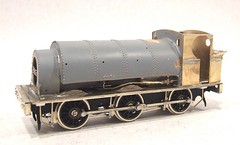OK, so this is looking a bit scruffy but a lot more complete. Before going any further than the last photo the tank received a coat of cheap primer. As I've mentioned before, this allows me to see the model as it is and not be deceived by the nice shiny brass. I'll be honest and say I was a little surprised to fine it had gone pretty well. Not perfect if I'm being picky, but good enough to continue.
The footplate has to be shortened before use. Two of the prototypes were involved in accidents and rebuilt slightly longer, and the kit allows for this. 4mm needs to be knocked off the back end for an early engine like this. The buffer beams are hefty fold ups as the real things were chunks of wood. Some of the photos appear to show them faced with a steel plate and I'd have replicated this if I'd spotted it before riveting the beams. Of course the pictures available tend to be of the locos later in life so that might not be accurate anyway.
Before bringing tank and footplate together there is the little matter of the prominent pipes under the tank which meant fitting some injectors. I'd hoped to make this whole lot removable to ease the painters job but this proved very difficult so I decoded to make something that looks good. I'm not sure you'd squeeze it under the tank anyway as the gap under there is surprisingly small and the splashers get in the way.
The cab is a simple enough construction - 4 sides that just have to be kept square. Sorting out the bunker back is an other matter. It has a very strange flare which points out in all directions and tapers back into the cab side. 3 parts are supplied which have to be bent and bodged into position with a fair bit of solder put in as a filler and then filed away to give a tidy result. The worst part is that the components have very sharp pointed ends and jabbed fingers are inevitable !

No comments:
Post a Comment